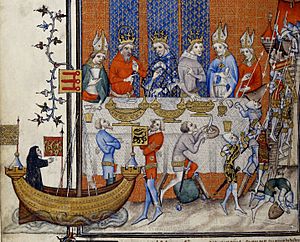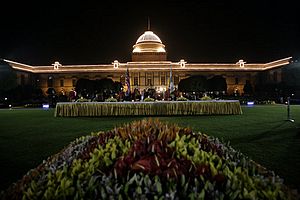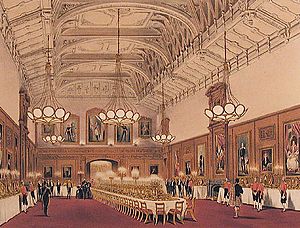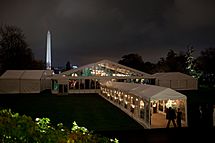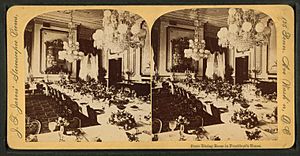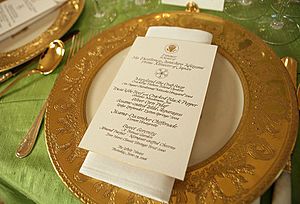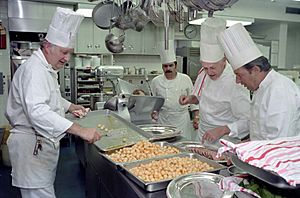State banquet facts for kids
A state banquet is a very special dinner hosted by a country's leader, like a president or a king. It's usually held at their official home for another country's leader. These dinners are a big part of a "state visit," which is when a foreign leader officially visits another country. They help celebrate the friendship and good relationships between countries.
Depending on the time of day, it might be called a state dinner or a state lunch. Many people attend, sometimes even hundreds! In Western countries, these events are very formal. Guests often wear fancy clothes like tuxedos or long dresses. There are usually military honor guards, a multi-course meal, music, and sometimes even dancing. The host and the main guest usually give short speeches and make toasts to each other.
Contents
History of State Banquets
Hundreds of years ago, it was hard and dangerous for kings and queens to travel. So, when they did meet, it was a huge deal! These meetings were celebrated with amazing feasts. For example, in 1363, the "Banquet of the Five Kings" in London brought together the kings of England, Scotland, France, Denmark, and Cyprus.
At these old banquets, the most important guests sat at a special table, often raised higher than the others. They might even eat different food! Many state banquets celebrated royal weddings, which were important for making alliances between countries. When these banquets became more common in Europe, the French court of King Louis XIV set the style for everyone.
Watching the Feast
In the past, especially in France, state banquets were like a show. Only a few royal people actually sat down to eat. But a huge crowd of courtiers (people who worked for the king) would stand around and watch. They were supposed to be quiet, like watching a play. Sometimes, the men stood on the main floor, and the ladies watched from balconies above. The dining table was often U-shaped, with everyone sitting on the outside, facing inward. This allowed the servants to move easily in the middle. These public meals showed off the king's power and importance. This style changed after the French Revolution but returned for a while under Napoleon.
The modern style of state banquets, with many guests all sitting down, began with King Louis Philippe I of France. In 1830, he invited 500 people to a banquet at the Chateau de Versailles. These guests were important people from different parts of society, not just courtiers. This is still how modern state banquets are held today. Often, there's one very large table, shaped like a "U" or "E," with the host and most important guests at the main part.
State Banquets Around the World
India's Grand Dinners
In India, state banquets are held for foreign leaders at the Rashtrapati Bhavan in New Delhi. The President of India hosts these events. Over a hundred guests usually attend, including important government officials and business leaders from both India and the visiting country.
The foreign leader is greeted by the President in a special room. The banquet often takes place outdoors in a tent set up in the Mughal Garden of the presidential palace. The gardens are lit up with traditional lamps and decorated with flowers. Guests enjoy performances by Rajasthani singers and Indian classical dances like Bharatnatyam and Kathak.
During the dinner, the President of India and the visiting leader give speeches about their countries' friendship. Guests enjoy delicious Indian food while the Indian Navy Band plays music. These banquets happen after an official welcome ceremony earlier in the day.
Switzerland's Unique Approach
In Switzerland, the country's leader is not just one person but a group called the Swiss Federal Council. Because of this, all seven members of the Federal Council (and their spouses) are invited to state dinners held in Bern during state visits.
United Kingdom's Royal Banquets
In the United Kingdom, the British monarch (the King or Queen) hosts state banquets. These are usually held at Buckingham Palace in London or sometimes at Windsor Castle. The ballroom at Buckingham Palace can seat about 170 guests. For example, when President Donald Trump visited in 2019, that many people attended.
Guests include many members of the royal family, a large group from the visiting leader's country, British politicians, and other important people. Everyone wears very formal clothes, and special decorations are worn. A single, very long table is used. The room also features a traditional display of beautiful gold and silver dishes, which are for show and not actually used.
The Master of the Household organizes these banquets. Planning starts months ahead, and the King and the Foreign Office approve the final seating plan. The meal has four courses: fish, a main dish, pudding, and dessert. They use a special 200-year-old dining service with 4,000 pieces! Each guest has six glasses for different drinks and many pieces of cutlery. The King chooses the menu from four options presented by the royal chefs. The food is prepared fresh by the Royal Household chefs. Before the dinner, the King personally checks the table, settings, music, and flowers.
Royal rules are usually very strict, but they have become a bit more relaxed recently. Speeches are checked by the Foreign Office. Gifts are also exchanged between the host and guests.
United States State Dinners
In the United States, a state dinner is a formal dinner hosted by the President. It honors a foreign head of state, like a king, queen, or president. These dinners are held in the State Dining Room at the White House in Washington D.C. Other formal dinners for important foreign guests, like a prince or princess, are called "official dinners." The main difference is who pays for them.
State and official dinners follow strict rules to avoid any diplomatic mistakes. Many people work together to plan these events. This includes the Chief of Protocol, the White House Chief Usher (who manages the White House staff), and the White House Social Secretary. The Graphics and Calligraphy Office creates place cards for guests and writes formal invitations. The White House Executive Chef and Pastry Chef plan the four or five-course meal. The Chief Floral Designer arranges flowers and decorations.
A state dinner usually happens after an official welcome ceremony on the White House South Lawn earlier in the day. In recent years, these dinners are often shown on TV channels like C-SPAN.
History of U.S. State Dinners
In the early 1800s, dinners honoring the President's Cabinet or Congress were sometimes called "state dinners," even without foreign guests. Washington, D.C., was much smaller then, and large gatherings were rare. Over time, the city grew, and state dinners became a regular part of the winter social season, honoring Congress, the Supreme Court, and foreign diplomats.
By the late 1800s, "state dinner" specifically meant a dinner hosted by the President for a foreign head of state. The first visiting head of state to attend a state dinner at the White House was King David Kalakaua of Hawaii. President Ulysses S. Grant hosted him on December 12, 1874.
When the White House was renovated in 1902, it became a more suitable place for official events. The President's office moved to the new West Wing, and the main rooms of the White House were redecorated. This gave President Theodore Roosevelt a perfect setting to show the United States' growing power. From 1948 to 1952, the White House was completely rebuilt inside. During this time, President Harry S. Truman and his wife lived elsewhere, and state dinners were held in local hotels.
Before the 1960s, long banquet tables were always used in the State Dining Room. However, First Lady Jacqueline Kennedy replaced them with round tables. These round tables could fit more guests, about 120 to 140, in the space. Today, presidents and first ladies still add their own style to these events. They use beautiful gilded candelabras, special crystal, and a collection of White House china that dates back to the early 1800s.
What Happens at a State Dinner
During a state dinner, honor guards and color guards from all parts of the U.S. military are present. The President and First Lady greet the visiting leader and their spouse at the North Portico entrance of the White House. The guests usually arrive in a motorcade from Blair House, a traditional guest house for foreign leaders. There's a quick photo opportunity for the media.
Then, the President and First Lady take their guests to the Yellow Oval Room for a reception. Here, guests are served appetizers, cocktails, wine, or champagne. The President and First Lady also introduce their guests to many important Americans, including ambassadors, members of Congress, Cabinet members, and even famous celebrities.
After the reception, the President and the foreign leader (followed by their spouses) walk down the Grand Staircase to the Entrance Hall. The United States Marine Band, known as "The President's Own," plays music. They play four "ruffles and flourishes" followed by "Hail to the Chief" for the President's arrival. Often, the national anthem of the visiting country and "The Star-Spangled Banner" are also performed.
Next, the President introduces the visiting leader to all the invited guests. Then, everyone walks to the State Dining Room. A four or five-course meal is served, usually including an appetizer, fish, meat, salad, and dessert. The menu is planned by the White House Executive Chef and Pastry Chef. It often features foods and flavors from the visiting country, using local ingredients.
Before eating, both the President and the visiting leader give speeches. They talk about the strong relationship between their countries. Violinists from the Marine Band, called the "Strolling Strings," play music for the guests as they eat. After the meal, guests move to the East Room for a formal musical performance by a famous musician, singer, orchestra, or band. Sometimes, dancing is also part of the evening.
See also


